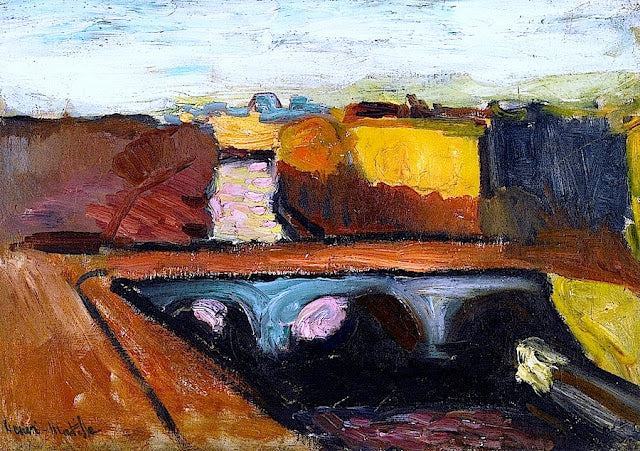Description
In the extensive and varied work of Henri Matisse, "View of the Seine: the Pont Saint-Michel" (1904) stands out as an early manifestation of his mastery of color and composition. This work, of relatively modest dimensions (64x46 cm), is framed in a crucial period in Matisse's evolution, where he begins to explore the limits of Fauvism, the artistic movement that, along with other creators like André Derain, he helped define.
Upon visual inspection of the painting, it is evident that Matisse employs a limited but vibrant palette to capture the atmosphere of the Seine and the iconic Pont Saint-Michel in Paris. Bluish and green tones dominate the canvas, conferring an almost dreamlike serenity to the scene. Unlike his later works, marked by strident colors and bold contrasts, this painting offers a harmonious blend that suggests a transition from his earlier Impressionist style towards the bold chromatic experiments of Fauvism.
The composition is structured around the Seine River, which diagonally traverses the canvas, directing the viewer's gaze towards the Pont Saint-Michel that rises in the background. The bridge, although clearly distinguishable, is reduced to basic shapes and flat colors, reflecting the modernist tendency to reduce figures to their essential elements. The buildings and structures lining the river are not meticulously detailed but are presented through quick strokes and color patches, capturing more of the general atmosphere than individual details.
This treatment of the urban scene highlights one of the most significant aspects of Matisse's work: his ability to convey the essence of a place through visual simplification. There is no human presence in this painting, which adds a sense of calm and stillness, allowing all attention to focus on the interaction of light and color, and the shapes that define the landscape.
It is relevant, in this context, to mention how Matisse's work from this period positions itself within the broader framework of art history. 1904 was a crucial year for Matisse; besides exploring Paris through his brushes, he began to closely associate with other artists who shared his interest in breaking away from academic painting traditions. This work, although seemingly simple, encapsulates Matisse's quest for a new aesthetic truth: one that found beauty in spontaneity and innovative use of color.
We can compare this painting with other contemporary works by Matisse, such as "Luxury, Calm and Pleasure" (1904-1905), where the simplification of color and form is taken to the extreme, heralding the rise of Fauvism in the following years. Although "View of the Seine: the Pont Saint-Michel" does not exhibit the same chromatic intensity, it shares the same artistic essence of rejecting excessive detail in favor of a more visceral and emotional impression of the environment.
In summary, "View of the Seine: the Pont Saint-Michel" stands as a significant piece within Henri Matisse's career, symbolizing a stage of transition and stylistic quest. Through his delicate handling of color and compositional simplification, the work not only offers a serene view of the Seine but also foreshadows the bold innovations that Matisse would continue to develop, consolidating him as one of the pioneers of modern art.

